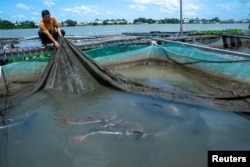A severe drought coupled with Chinese dams blocking the Mekong River as Beijing moves to meet power demands means one of the world's mightiest rivers is likely to face severe water shortages this summer.
This will directly create food insecurity with lower crop yields due to irrigation problems and a reduction in nutrient-rich sediment delivered by the Mekong.
Indirectly, the reduced water flow will impact the economies of downstream Southeast Asian nations, according to experts who say the loss of food sourced from the Mekong will drive up prices and cause increased hunger, reducing worker productivity.
"Climate indicators suggest there is a severe drought developing in the Mekong," said Brian Eyler, senior fellow and director of the Southeast Asia Program at the Stimson Center, who spoke after a recent event in Washington on the Mekong.
The Mekong River is Asia's third-largest transboundary river, stretching nearly 5,000 kilometers from China through six countries where it serves as the primary or secondary food source for millions of people.
The El Nino weather pattern developing this summer is expected to reduce precipitation, causing a severe drought and dramatically reducing water levels on the Mekong, according to experts at the Stimson Center who presented the assessment of river conditions last month.
The situation is expected to be exacerbated by how China uses its 11 dams straddling the Mekong's upper reaches.
China takes "water out of the river during the wet season and then puts it back during the dry season for hydropower production," said Eyler. "That exacerbates the kind of drought conditions that are setting in now."
He added that China "needs to recognize that wet season flows need to be robust, and to date, China denies this."
China has been repeating the pattern for years. In 2020, China's dams removed "as much water" as possible and withheld 10% of the water from the Mekong, reducing the flow of the river downstream during the wet season, said Eyler.
Chinese Embassy spokesperson Liu Pengyu in Washington told VOA's Korean Service on Thursday that there is no specific information to share on the situation this summer. But he did mention that in the past, "the international science community and the Mekong River Commission [MRC] have already made a fair judgment on the role of dams on the upper reach of the Lancang River."
China refers to the Mekong River as the Lancang.
Pengyu continued, "The MRC acknowledged in its report that cascade reservoirs on the Lancang River store water in the flood season for later use in the dry season, which helps maintain the steady flow of the Mekong." He added that Beijing has been providing "year-round hydrological information" on the river and making "contributions to sharing the water resources."
The MRC, an intergovernmental organization that fosters cooperation among Cambodia, Laos, Thailand and Vietnam to manage water resources along the Mekong, has invited China to join the commission, according to Anoulak Kittikhoun, the MCR's chief of mission.
"We have opened for China and Myanmar to join [the commission] for a long time," but "they still do not want to join," said Kittikhoun. "They said they have been increasingly cooperative."
Kittikhoun said the two countries have been dialogue partners since 1996 and have engaged in discussions, joint studies, technical workshops and personnel exchanges "to increase understanding between upstream and downstream countries."
However, he added, "Most upstream countries tend to have different perspectives from downstream countries in terms of river management. … If we talk about obligations or law, it is another perspective."
China's two largest dams, Xiaowan and Nuozhadu, both in southwestern Yunnan Province, hold more water than the 53 dams tracked by the Mekong Dam Monitor, which Eyler co-leads. There are 430 dams, 11 of them in China, along the entire Mekong.
The river widens and quickens when there is plenty of rainfall during the wet season, from June to November. It contracts during the dry season of December to May.
When there is a drought, Chinese dams blocking the river worsen conditions downstream, creating food insecurity for nearly 60 million people in countries such as Cambodia, Laos, Thailand and Vietnam that rely on the river for agriculture and fisheries.
Cambodia relies heavily on fisheries in the lower Mekong River Basin for protein intake, and Vietnam produces about 50% of the country's rice using water from the Mekong Delta.
Prices of Thai and Vietnamese rice soared in July with the expected drought and the rise in global rice demand. Thailand and Vietnam are the world's second- and third-largest rice exporters after India.
"If there's food security crisis, then the industry suffers as well as labor," said Eyler. "If there's no food on the table, then you can't grow economically. Water security is one thing, but water underpins the food security of these countries. And [if] people are starving, what chance is there for economic growth?"
Since the pandemic, economic growth in some Southeast Asian nations has come from their emergence as an attractive alternative location for supply chain networks currently in China.











